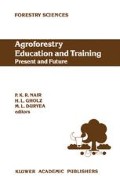Abstract
Agroforestry has been incorporated in education and training programs at an unprecedented level since 1982. A survey of educational institutions conducted by ICRAF in 1987 revealed that agroforestry is found as an option for specialization in undergraduate as well as in postgraduate M.Sc. diploma programs in forestry, agriculture, natural resources, and others. Courses and special seminars in agroforestry are organized in degree programs. Full undergraduate and postgraduate programs in agroforestry are being formulated and implementation started in quite a few universities, and many students are choosing agroforestry-oriented research projects for their dissertations. A good setting for higher degree training in agroforestry requires, however, staffing from combined faculties of at least agriculture, animal science and forestry; faculty commitment to a farming systems approach; and inter-departmental cooperation in teaching and research. It was difficult to assess whether these and other elements are present in existing programs where agroforestry has been incorporated. Emerging trends indicate that traditional forestry programs are broadening the scope of the discipline (from forests to integrated land-use systems) while agriculturists are recognizing that trees play important roles as soil improvers and protectors, fodder, food, fuel and other domestic and commercial purposes. New institutional structures are evolving to allow for educational programs with coursework and research projects spanning many disciplines. Nondegree training in agroforestry has seen an upsurge of activities equal, if not larger, to that in education. Attempts are being made by different institutions worldwide to inventory training opportunities; still the collection and dissemination of information is difficult. Efforts are needed at the international, regional, and national levels, to address training issues that if addressed collectively can improve the quality and effectiveness of human resource development efforts. ICRAF’s approach to promote agroforestry research through education and training is an example of an action program currently under application.
Access this chapter
Tax calculation will be finalised at checkout
Purchases are for personal use only
Preview
Unable to display preview. Download preview PDF.
References
Contant RB (1980) Training and education in agroforestry. In: Chandler T and Spurgeon D (eds.). International cooperation in agroforestry: Proceedings of an international conference, pp. 191-218. ICRAF, Nairobi
Huxley PA (1980) Agroforestry at degree level: a new program structure. In Chandler T and Spurgeon D (eds.). International cooperation in agroforestry, pp. 219-227; ICRAF, Nairobi
Huxley PA (1982) Education for agroforestry. A discussion paper presented at the United National University Workshop on Agroforestry, Freiburg, Germany. 31 May-5 June
Lundgren B (1987) Institutional aspects of agroforestry research and development. In: SteppIer HA and Nair PRK (eds). Agroforestry: A decade of development, pp 43-66. ICRAF,Nairobi
Schuh EG (1987) Policy and research priorities for agroforestry. Paper delivered at the 10th Anniversary Conference of ICRAF, 7-11 September, 1987, Nairobi
Steppler HA and Nair PKR (eds)(1987) Agroforestry: A decade of development. ICRAF, Nairobi
Summary Report (1987) International Agricultural Research Centers' workshop on human resource development through training, 12-16 September, 1988. International Potato Center, Lima
Zulberti E (ed)(1987) Professional education in agroforestry: Proceedings of an international workshop. ICRAF, Nairobi
Zulberti E (1987) Agroforestry training and education at ICRAF: Accomplishments and challenges. Agroforestry Systems 5: 353-374
Author information
Authors and Affiliations
Editor information
Editors and Affiliations
Rights and permissions
Copyright information
© 1990 Kluwer Academic Publishers
About this chapter
Cite this chapter
Zulberti, E. (1990). Agroforestry education and training programs: an overview. In: Nair, P.K.R., Gholz, H.L., Duryea, M.L. (eds) Agroforestry Education and Training: Present and Future. Forestry Sciences, vol 35. Springer, Dordrecht. https://doi.org/10.1007/978-94-009-2095-8_2
Download citation
DOI: https://doi.org/10.1007/978-94-009-2095-8_2
Publisher Name: Springer, Dordrecht
Print ISBN: 978-94-010-7441-4
Online ISBN: 978-94-009-2095-8
eBook Packages: Springer Book Archive

